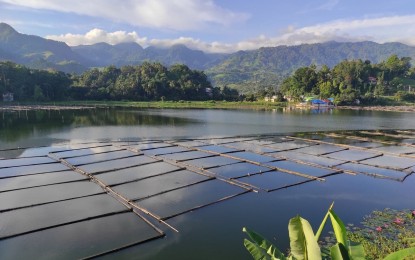
The thriving fish cages in Barangay Poblacion of Lake Sebu, South Cotabato (PNA GenSan file photo)
GENERAL SANTOS CITY – The provincial government of South Cotabato is pushing for the expansion of hydroponics farming in the critical Lake Sebu to help improve the quality of its waters and overall condition.
Siegfred Flaviano, head of the Provincial Environment Management Office (PEMO), said Monday they are currently working with the local government of Lake Sebu and other stakeholders for the establishment of more hydroponic gardens within the 354-hectare lake.
He said studies showed that hydroponics, which is a method of growing plants or crops without soil and by using mineral nutrient solutions in an aqueous solvent, could be a “natural remedy” to the declining condition of the lake’s waters.
Flaviano specifically cited the deterioration these past years of the lake’s dissolved oxygen level, a situation that has triggered perennial fish kills, with the latest only recorded last January.
“The presence of more hydroponic gardens at the lake could help enhance the dissolved oxygen in its waters and address its waste problem,” he told reporters.
He said the natural wastes that have long accumulated at the lake may be processed and used as fertilizers for the hydroponic gardens.
The provincial government, through PEMO, launched the hydroponics program in 2016 as part of the Lake Sebu Rehabilitation, Conservation, and Development Program.
Flaviano said they trained at least 25 households in the area regarding the innovative system that helped establish vegetable gardens along the lake.
The program has so far thrived, with the household-beneficiaries now selling their “organic and chemical-free” vegetables such as lettuce to the area’s hotels and resorts.
“By expanding the program, we will not only help save the lake but provide alternative livelihood to residents as well,” he said.
Flaviano said the program will complement the continuing regular clean-up activities at the lake conducted by PEMO and the municipal government as well as the rehabilitation of its watershed areas.
Last year, he said their enhanced reforestation program covered at least 12 hectares of the lake’s watershed and areas within its water sources.
The official said they are continually monitoring the “health condition” of Lake Sebu through the assigned lake wardens.
He said they are currently working on the purchase of at least two dissolved oxygen test kits to help stakeholders better prepare in case of a possible fish kill.
Fishery experts said the fish kills were caused by the occurrence of “kemohung,” a phenomenon triggered by the sudden rise in the water’s temperature.
“Kemohung,” which usually occurs during the rainy season, triggers the rise of sulfuric acid that eventually lowers the dissolved oxygen in the lakes' waters.
The fish kill last January devastated around 200 tons of tilapia worth PHP20 million. In 2017, portions of the lake were hit by a series of major fish kills that destroyed 1.4 million kilos of tilapia valued at around PHP126 million. (PNA)
